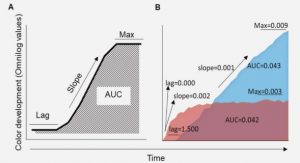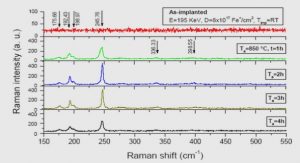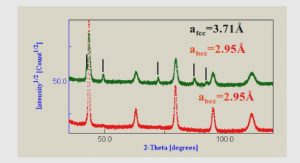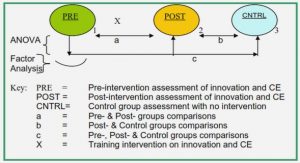Get Complete Project Material File(s) Now! »
Chapter 3 Context of the Study
The Amhara National Regional State (ANRS)
The Amhara National Regional State (ANRS) is located in the north western and north central parts of Ethiopia. The Region is rich in natural resources such as water, suitable land for agriculture, large livestock population, hardworking people and varied agro-ecological zones (SIDA, 2010). Despite these potentials, the Region suffers from deep-rooted poverty and food insecurity caused by meteorological drought, hydrological drought, agricultural drought, high population pressure, resource degradation and poor infrastructure. From the total 126 districts, 64 (51%) districts including Lay Gaint are currently food insecure and all are located in the eastern part of the ANRS (Figure 3.1). Overall- 2-3 million people are chronically food insecure accounting for one-third of the chronically food insecure and vulnerable people in the country (Ayalew et al., 2012).
The Study Area: Lay Giant District
Physical Features
Location and topography: Lay Gaint district is located in South Gondar Administrative Zone of the ANRS. It lies within 110 04′ to 120 10′ N latitude and 380 12′ to 380 37’E longitude (Figure 3.2), and covers a total area of 1,320.31 km2 composed of 19 rural kebeles. With a total population of 242,306, the population density is about 184 persons per square kilometer. The population density of the district is higher than in the Amhara region (112 persons per square kilometer) (CSA, 2006) and the nation‟s average (67 persons per square kilometer) (EDHS, 2012). Lay Gaint is the fifth largest district and accounts for 11% of the total area in South Gondar Administrative zone. The district town, Nefas Mewcha is located 741 km a road distance away from Addis Ababa and 175 km a road distance far from Bahir Dar.
The topography of Lay Gaint district like the other districts in the zone comprises of dissected plateaus, peaked mountains, mountain ridges and deep gorges. It has wide variations of altitude ranging from less than 1500 to more than 4000 m asl (Figure 3.3). From the three agro-ecological2 zones, the Kolla zone of Lay Gaint district located entirely in the Tekeze river basin is the most inaccessible and rugged in physical settings. Aklilu et al. (2000) pointed that the Kolla and Woina-Dega zones of Lay Gaint have the most rugged and degraded topography, while the Dega zone has relatively elevated but flat topography. Similarly, Guinad (2001) stated that the Tekeze river basin of the Kolla zone is considered to be among the most inaccessible and rugged areas in the study district. The district agricultural expert also noted that the Kolla zone is characterized by rugged topography, while the Woina-Dega zone is flat to slightly rugged and the Dega zone is almost flat with the exception of some highly elevated places dominated by rugged topography.
As it can be seen in Figure 3.4, the southwestern part of the district is dominated by Dega agro-ecology has gentler slope but the central and the northern parts of the district are characterized by Woina-Dega and Kolla agro-ecological zones, respectively have steeper slopes. About 75% of the total area in the Dega zone is gentler slope with better soil fertility, while 90% of the Kolla zone is steeper slope exposed for severe soil erosion and covered with infertile soils (Aklilu et al., 2000). In general, the relief of the district is composed of mountainous (15%), flatland (10%), rugged topography (70%) and dissected valleys (5%) (WAO, 2011).
Soils: The two major soil types, widely distributed in the study area include Vertic Cambisols (23%) and Lithic Leptosols (70%) (Figure 3.5). Leptosols are dominantly found over the residuals of the trachyte of the upper slopes. They are mainly characterized by shallow depth below 30 cm (Engdawork, 2002). In general, Lithic leptosols are very widespread in the study area and they can be found only at very steep slopes on similar environments like that of Eutric Cambisols. Cambisols are a mixture of red and black soils. When such kind of soils are found on gentler slopes combined with clay content, they have the properties of Vertic Cambisols. As far as soil distribution in the district is concerned, black and red (Cambisols) soils, black (Vertisols) soils and Leptosols soils are the dominant ones (Aklilu et al., 2000). Regarding fertility, Cambisols are the best soils followed by Vertisols soils, but Leptosols are the least fertile soils (Aklilu et al., 2000). As information obtained from the district agricultural office, fertile lands account for 10%, moderately fertile lands (35%), and infertile (waste) lands account for 55%. In general, soil degradation in the study area is regarded as the major constraint to crop production next to drought. Aklilu et al. (2000) have identified the causes for the poor soil fertility of Lay Gaint district as declining crop rotation due to limited farm size, increasing soil erosion and limited use of organic and inorganic fertilizers with the declining use of manure.
Drainage systems: The main drainage systems are found in the Tekeze and Abay River systems discharging towards north and south of Lay Gaint, respectively (Guinad, 2001).
Thus, Lay Gaint is used as a watershed separating the two major river systems to flow into different directions. Large areas of the district are found in the Tekeze drainage system.
Climate: The mean minimum and the mean maximum temperature lie within 50C and slightly greater than 200C (Figure 3.6). According to Lay Gaint District Agriculture Office (2011), the mean minimum and mean maximum temperature for the study district ranges between 50C and 240C, respectively. Specifically, mean annual maximum temperature is the highest from March to May and mean annual minimum temperature is the lowest from December to January (Figure 3.6). Halonen et al. (2009) also confirmed that the hottest period in Ethiopia in general is from March to May, while the lowest annual minimum temperatures occur in the highlands between the months of November and January. The rainy seasons in the study area include Belg (little rain) and heavy Kirmet (heavy rains) with erratic distribution varying from 600 mm to about 1200 mm (Figure 3.7).
Chapter 1 Introduction
1.1. Background of the Study
1.2. Statement of the Problem
1.3. Objectives of the Study
1.4. Research Questions
1.5. Significance of the Study
1.6. Scope and Limitation of the Study
1.7. Organization of the Thesis
Chapter 2 Review of Related Literature
2.1. Introduction
2.2. Theoretical Foundations of Food Security
2.3. Responses to Shocks: Coping and Adaptive Strategies
2.4. The Livelihood Studies
2.5. Food Security Situations in Ethiopia
2.6. Conceptual Framework of the Study
Chapter 3 Context of the Study
3.1. The Amara National Regional State (ANRS)
3.2. The Study District: Lay Gaint
3.3. Crop Production and Rainfall Trends in the Study Area
3.4. Drought Prone Areas of Lay Giant District
3.5. Productive Safety Nets Program (PSNP) of Lay Gaint District
Chapter 4 Research Design and Methodology
4.1. Case Study Research Design
4.2. Field Work for the Study
4.3. Selection of Sample Sites and Sample Households
4.4. Data Collection and Analysis
Chapter 5 Demographic Characteristics of Respondents
5.1. Introduction
5.2. Age and Sex composition of the Households
5.3. Family Size
5.4. Marital Status of the Households
5.5. Female-headed Households and Food Security
5.6. Conclusion
Chapter Rural Households’ Livelihood Assets, Strategies and Food Security Outcomes
6.1. Introduction
6.2. Livelihood Assets of the Sample Households
6.3. The Livelihood Strategies of the Sample Households
6.4. Conclusion
Chapter 7 Households’ Perceptions and Coping/Adaptive Strategies to Climate Variability
and Change
7.1. Introduction
7.2. Households‟ Perceptions about Climate Variability and Climate Change
7.3. Households‟ Perceptions about the Definitions and Causes of Drought
7.4. Households‟ Perceptions of the Dissemination of Climate Information
7.5. The Nexus between Rainfall Variability, Crop Production and Food Security: Households’ Perceptions
7.6. Analysis of Rainfall Variability in Lay Giant District
7.7. Households‟ Coping and Adaptive Strategies
7.8. Conclusion
Chapter 8 Analysis of Vulnerability to Food Insecurity
8.1. Introduction
8.2. Conceptual Framework
8.3. livelihood Assets and Households‟ Vulnerability to Food insecurity
8.4. Other Factors Influencing Households‟ Vulnerability to Food Insecurity
8.5. Food security Status of the Households
8.6. Incidence, Depth and Severity of Food Insecurity
8.7. Determinants of Household Food Insecurity
8.8. Conclusion
Chapter 9 Conclusions and the Way Forward
9.1. Conclusions
9.2. The Way Forward
GET THE COMPLETE PROJECT
Determinants of Rural Household Food Security in DroughtProne Areas of Ethiopia: Case study in Lay Gaint District, Amhara Region






